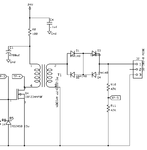MexicoMac
Newbie level 2

I am looking for a circuit diagram for a high power ultrasonic amplifier. Needs to drive an underwater transducer rated at 50 watts. Currently using a single Hfet driving a 1:25 toroid to 1000vpp, but I need to increase the duty cycle past 1% for more output power. I think a dual HFet design with a dual DC power supply would work best.
Any ideas would be appreciated.
Thanks,
Mac
Any ideas would be appreciated.
Thanks,
Mac




